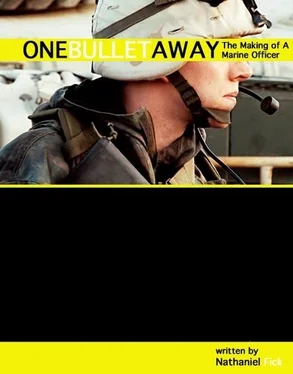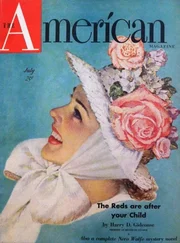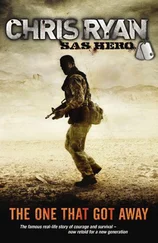The Corps teaches three fundamentals of marksmanship: sight picture, bone support, and natural point of aim. Sight picture is lining up the rifle’s front and rear sights with the target — a simple enough proposition. Bone support means resting the rifle on the steadiest surface available: bone. Muscles and tendons waver and shake, but bone resting on earth is like a tripod for a camera. The third element, natural point of aim, is the most important. With each of the shooter’s breaths, the rifle muzzle rises. It settles with exhalation back to a natural resting point between breaths — the natural point of aim. Make the bull’s-eye your natural point of aim, squeeze the trigger near the bottom of your breath, and you’ll hit the target.
For two weeks, we ran through the fundamentals, arriving at the range in the predawn darkness and staying until midafternoon. I learned that consistency is key, and I was maniacal about it: same (light) breakfast each morning, same layers of clothing, same method of cleaning my rifle at the end of each day. The weather was gorgeous, cool mornings giving way to warm sun with almost no wind. It was perfect shooting weather.
We began firing for score in the third week, but only Thursday would count. There were 300 possible points on the course, and I needed 220 to qualify as an Expert. On Monday, I shot 180. Tuesday, 210. Wednesday, 220. Hovering at the cusp, I went to bed Wednesday night thinking about consistency. I had to replicate everything perfectly. The only element out of my control was the weather.
I woke at 0400 on Thursday and pulled open the blinds on my only window. Rain streaked the glass, and naked trees danced in the wind. A cold December morning. Damn. We drew our weapons from the armory and formed up in the parking lot outside Graves Hall for the three-mile hike to the range. Less than an hour after crawling out of my warm bed, I was chugging up the aptly named Cardiac Hill, a steep climb from a creek bed made more difficult by the mud, my heavy pack, and a line of vomiting lieutenants whose breakfasts had been heartier than mine.
It was still dark when we reached the range. I could barely make out the red wind flags through two hundred yards of blowing mist. They snapped parallel to the ground, the strongest wind I had ever shot in. I sat on my ammo can in the dark, shivering and waiting for enough light to start. I thought about the fundamentals as I rubbed a clear spot on the frosty ground at the two-hundred-yard line. Sight picture, bone support, natural point of aim. Do what you’ve been taught, and you’ll hit the target.
Chills shook my body. I had a sweater and jacket in my pack but fought the urge to put them on. Consistency. I hadn’t worn a jacket on the warm days earlier in the week. That extra millimeter of fabric on my arm now would have an outsize effect on the little black disk five football fields away. I willed myself warm.
“With a magazine of ten rounds, load!” The range master’s voice echoed through the fog from his perch in the tower above and behind us.
“Make ready!” I racked my charging handle to the rear and chambered a round.
“Shooters, you may fire when your targets appear.”
I settled my breathing, letting the muzzle rise and fall naturally. I centered the rifle’s front sight post in the aperture of the rear sight and put it on the black target. I pulled my elbows in tight to my body, squirming in the mud to make one connection between rifle, bone, and dirt. Breathing naturally, I made little adjustments until every exhalation put the target in the center of my sights. Then I squeezed the trigger.
Wide to the right. I dialed in a click of windage to correct for the gusts and fired again.
Wide to the right.
Relax. Easy breaths. Back to the basics. Ignore the distractions. No cold, no rain, no wind. Do what they taught you. Line it up. Good support. Easy trigger pull.
Bull’s-eye.
My next twenty shots were all in the black. Shooting was mechanical, rote. The key, as we’d heard so many times, was practicing the stroke and making it instinct. The only skill involved was learning the lessons of those who’d gone before. By the time I walked off the five-hundred-yard line, I had shot a 231.
Learning institutional lessons is the overarching theme of the classes at TBS. Our instructors were fond of pointing at the pile of tactics manuals on each of our desks and saying, “These books are written in the blood of lieutenants and captains who went before you. Learn from their mistakes; don’t repeat them.” The Marine Corps adheres to a crawl-walk-run philosophy, so we spent much of our time in the classroom before going out to the woods to practice what we’d learned. In the beginning, that learning was formulaic, just like OCS.
We learned the six troop-leading procedures by the acronym BAMCIS. Begin planning. Arrange for reconnaissance. Make reconnaissance. Complete the plan. Issue the order. Supervise. We used METT-T to estimate a tactical situation in order to complete the plan: mission, enemy, terrain, troops and fire support available, time. Most of all, we began to issue orders. Not yelled commands in mid-assault, but multipage written orders built around the five-paragraph format called SMEAC: situation, mission, execution, administration and logistics, command and signal. We wrote dozens of them.
Instruction at TBS goes far beyond rote memorization, growing into some amalgamation of chess, history, boxing, and game theory. We studied the fog and friction of war, how the simplest things become difficult. During our written test on the subject, the instructors cranked Metallica at full volume, hurled tennis balls at our heads, and sprayed our faces with water pistols. The lesson was focus: ignore the distractions and do your job.
We learned about warfare’s dynamism. We wouldn’t be fighting wax men in castles. In our instructors’ words, “The enemy has a vote, too.” When confronting an opposing will, we fight people who are also fighting us. They will learn as we learn. Their tactics will evolve as ours do. The key consideration in any tactical move is “to turn the map around.” Look at your own situation from the enemy’s perspective. What are your vulnerabilities? Where will he hit you, and what can you do to defeat him?
Speed, we were taught, is a weapon. Be aggressive. Keep the tempo high. The Marine Corps’s hallmark is maneuver warfare, slipping around the enemy’s hard surfaces and into his open gaps. Never attack into the teeth of the guns. We learned that indecision is a decision, that inaction has a cost all its own. Good commanders act and create opportunities. Great commanders ruthlessly exploit those opportunities and throw the enemy into disarray.
The focus on commanders recognized that war is a human enterprise. Even in the twenty-first century, wars are fought by people, not machines. Commanders must command from where they can influence the action. Marine officers, we were told, lead from the front. They thrive on chaos. We learned that the Corps relies on mission-type orders: “Tell me what to do, not how to do it.” Decentralize command and allow subordinates to operate freely within the framework of the commander’s intent. Train them as a team. Develop trust, loyalty, initiative.
This is the art of war. Some of the terms were new, but the principles had been recorded by Thucydides, Sun Tzu, and Clausewitz. We wanted to get out in the woods and apply them.
OUR EVALUATION AT TBS was in three columns: leadership, academics, and military skills. The last was the most significant, and first among those skills was tactical command. We spent much of the winter in the woods and fields surrounding Camp Barrett, practicing tactics as squads and platoons. We attacked and defended, ambushed, raided, patrolled, and did reconnaissance. Lieutenants rotated as leaders of the missions. Before every operation, the leader wrote and delivered a formal order. Sometimes the orders stretched into dozens of pages, accounting for every detail of navigation, communication, resupply, and actions upon running into the enemy.
Читать дальше












